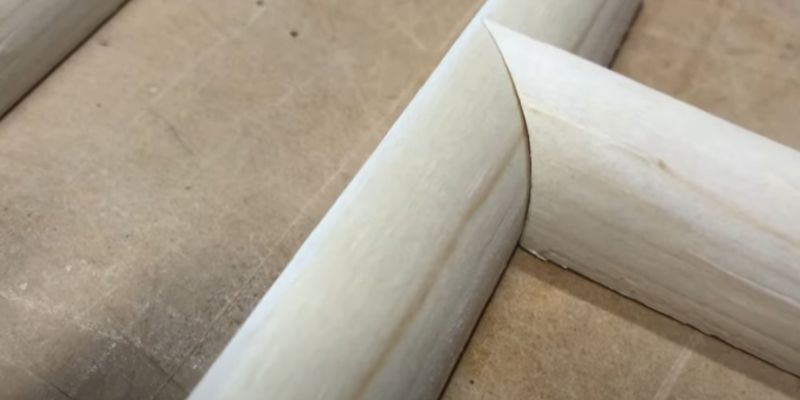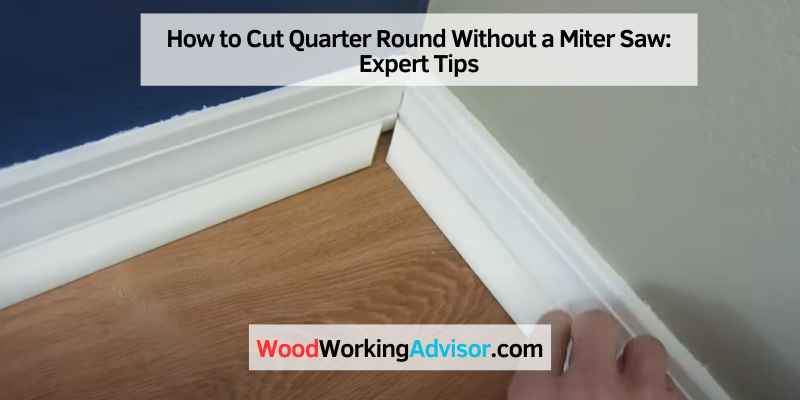To cut quarter round without a miter saw, use a coping saw and a miter box to achieve precise and clean cuts. Start by measuring and marking the quarter round before securing it in the miter box for cutting with the coping saw.
This method allows you to create seamless joints and angles without the need for a miter saw. When it comes to finishing flooring projects, cutting quarter round without a miter saw can be a challenge. However, with the right tools and technique, it can be accomplished with ease and precision.
Whether you’re a seasoned DIY enthusiast or a beginner looking to tackle home improvement projects, learning how to cut quarter round without a miter saw can be a valuable skill. In this guide, we’ll explore the step-by-step process and tools required to cut quarter round with accuracy and finesse, ensuring a professional-looking finish for your flooring installation.
Choosing The Right Hand Saw
When it comes to cutting quarter round without a miter saw, choosing the right hand saw is crucial. While a miter saw is typically the go-to tool for cutting quarter round, using a hand saw can be an effective alternative, especially when a miter saw is not available. Selecting the appropriate hand saw for this task can make a significant difference in achieving precise and clean cuts.
Hand Saw Varieties Appropriate For Fine Cuts
When it comes to cutting quarter round without a miter saw, choosing the right hand saw is crucial. While a miter saw is typically the go-to tool for cutting quarter round, using a hand saw can be an effective alternative, especially when a miter saw is not available. Selecting the appropriate hand saw for this task can make a significant difference in achieving precise and clean cuts.
Blade Types For Precision Woodworking
Hand saws designed for fine cuts often feature a smaller tooth count for smoother cutting and greater control. The Japanese pull saw, with its thin, flexible blade and razor-sharp teeth, is particularly well-suited for trimming quarter round without a miter saw. This type of saw allows for clean, precision cuts with minimal splintering, making it a top choice for achieving fine carpentry work.

Marking Angles Accurately
When it comes to cutting quarter round without a miter saw, marking angles accurately is crucial for achieving precise cuts. While a miter saw is the ideal tool for this task, there are alternative methods that allow for accurate angle marking. This article will explore measuring tips and tools that can help transfer angles without a miter saw, ensuring precise cuts for your quarter round molding.
Measuring Tips For Precise Angles
When measuring angles for cutting quarter round without a miter saw, it’s essential to ensure accuracy. Here are some measuring tips to help you achieve precise angles:
- Use a protractor to measure the angle required for the cut.
- Ensure the protractor is positioned flush against the straight edges of the quarter round to obtain an accurate reading.
- Mark the angle with a pencil or a marking tool, and double-check the measurement before making any cuts.
Tools For Angle Transfer Without A Miter Saw
Transferring angles accurately without a miter saw requires the use of specific tools. Here are some essential tools for angle transfer:
- Angle finder: A digital angle finder can accurately measure and transfer angles for precise cuts.
- Bevel gauge: This tool allows you to capture and transfer angles from the quarter round to the cutting device with ease.
- T-bevel: A T-bevel can be used to transfer angles directly from the quarter round to the cutting device, ensuring precision in angle marking.
Hand Saw Cutting Techniques
In woodworking, cutting quarter round without a miter saw might seem challenging at first, but with the right techniques and tools, it can be done efficiently. Hand saw cutting techniques provide a practical and effective method for achieving precise cuts on quarter round molding. Whether you’re a DIY enthusiast or a professional, mastering these techniques can help you achieve clean and accurate results without the need for a miter saw.
Securing The Quarter Round For Cutting
When cutting quarter round without a miter saw, securing the molding is crucial to ensure safety and accuracy. Place the quarter round molding securely on a stable and flat surface, such as a workbench or sawhorse, to prevent any movement during the cutting process. Using clamps or a vice can further stabilize the molding, minimizing the risk of slips or inaccuracies.
Guiding A Hand Saw For Straight Cuts
Select a high-quality hand saw with fine teeth, ideally a miter box saw or a backsaw, to attain straight and clean cuts. Ensure the saw blade is sharp and properly tensioned for optimum performance. Position the saw blade perpendicular to the quarter round and create a straight, guiding line with a pencil, ensuring precise cuts. Steadily guide the hand saw along the marked line, applying even pressure to maintain a consistent cutting motion. Maintaining focus and control is essential for achieving accurate and smooth cuts.
Expert Tips To Mimic Miter Saw Precision
- Use a miter box as a guide to assist in keeping the saw blade at the correct angle for angled cuts
- Invest in a quality coping saw for intricate or curved cuts, allowing for greater maneuverability
- Consider using a sturdy workbench vise to securely hold the quarter round in place for increased stability during cutting
- Regularly check and maintain the sharpness of the hand saw blade for optimal cutting performance
Perfect Angles With A Coping Saw
To cut quarter round without a miter saw, achieving perfect angles with a coping saw is essential. Holding the saw at the correct angle and making precise cuts will ensure clean and accurate results for trim work. With the right technique and attention to detail, using a coping saw can produce professional-looking cuts for your project.
Advantages Of Using A Coping Saw
When cutting quarter round without a miter saw, using a coping saw offers several advantages. One of the main benefits is the ability to achieve perfect angles to ensure a seamless fit, especially for inside corners. Additionally, a coping saw allows for greater control and flexibility, making it easier to navigate intricate cuts and complex angles compared to other cutting tools. This versatility makes it a valuable tool for any DIYer or professional carpenter.
Step-by-step Guide To Coping Quarter Round
Here’s a simple step-by-step guide to coping quarter round using a coping saw:
- Measure and mark the length needed on the quarter round molding, ensuring an accurate cut.
- Secure the quarter round firmly in place using clamps or a vice to prevent any movement during cutting.
- Position the coping saw at a 45-degree angle to make the initial cut, following the contour of the molding’s profile. Ensure a steady and even stroke to create a smooth, precise cut.
- Once the initial cut is made, use the coping saw to delicately remove the waste material by following the profile of the molding with short, controlled strokes.
- Test-fit the coping cut piece against the adjoining molding for a snug and seamless fit. Make any necessary adjustments for a perfect match.
By following these steps, you can achieve precisely coped quarter round without the need for a miter saw, ensuring a professional finish for your trim work.

Refining And Installing Quarter Round
Now that you have successfully cut the quarter round without a miter saw, it’s time to refine and install it to give your space a polished look. In this section, we’ll cover sanding techniques for a flawless finish and best practices for aligning and nailing quarter round.
Sanding Techniques For A Flawless Finish
Before installing the quarter round, it’s essential to ensure a smooth and flawless finish. Here are the sanding techniques to achieve a professional look:
- Start with a 120-grit sandpaper to smooth out any rough edges or imperfections.
- Gradually progress to higher grit sandpapers, such as 220-grit and 320-grit, to achieve a silky-smooth surface.
- Use a sanding block or sponge to maintain flat and even surfaces.
- Remove any dust and debris with a tack cloth before proceeding to the installation.
Best Practices For Aligning And Nailing Quarter Round
Proper alignment and nailing are crucial for a professional-looking installation. Follow these best practices for perfect quarter round alignment and secure nailing:
- Start with measuring and mitering the quarter round precisely to fit the corners and edges of the room.
- Apply a small bead of construction adhesive on the back of the quarter round before pressing it into place for added stability.
- Using a nail gun or hammer, drive finishing nails into the quarter round at an angle to secure it to the baseboard and ensure a seamless finish.
- Fill any nail holes or gaps with wood filler that matches the color of the quarter round to achieve a cohesive appearance.
Frequently Asked Questions For How To Cut Quarter Round Without A Miter Saw
How Can I Cut Quarter Round Without A Miter Saw?
You can use a coping saw with a miter box to cut the quarter round. Another option is to use a handsaw or a jigsaw, making sure to measure and mark the cuts accurately. Additionally, a small hacksaw can also be used for cutting precise angles.
What Are Alternative Tools For Cutting Quarter Round?
Besides a miter saw, you can use a backsaw, pull saw, or a multi-tool with a flush-cutting blade to cut quarter round. A coping saw is also effective for making intricate cuts. Each alternative tool requires careful measuring and cutting to ensure a precise fit.
Can I Use A Utility Knife To Cut Quarter Round?
Yes, a sharp utility knife can be used to score the finish of the quarter round before making the final cut. This method is suitable for thinner quarter round pieces or for creating small notches or detailed cuts. Ensure the blade is sharp and replace it if it becomes dull to maintain precision.
Conclusion
Cutting quarter round without a miter saw is definitely achievable with the right tools and techniques. By using a coping saw or a handsaw with a miter box, you can neatly and accurately cut the quarter round for your home improvement projects.
These alternative methods can help you save time and money, making your DIY tasks easier and more accessible.


